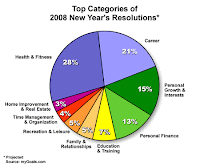While we're on the topic of lists and things to come in 2008 … cultural trend “experts” Iconoculture has unveiled its perspective of the top eight cultural trends that will drive consumer behavior in 2008. While most of items on the list illicit more of a “duh” than an a “hmm,” there are a few interesting tidbits and one or two thoughts that are germane to our little world.
The eight major trends identified by Iconoculture's “Consumer Strategists,” complete with subtle sales pitches, include:
TREND I: Group Solving - From the subprime mortgage meltdown, to the health insurance conundrum, consumers are facing intense personal financial crises in the coming year. There is an emergent cultural desire - even a demand - from consumers for companies and government agencies to intervene and help solve problems on a group level.
TREND II: Experts 2.0 - Consumers today are saturated with user-generated content and information from a million (sometimes dubious) sources. This year looks for the return of the expert. Companies that can reestablish credentials with consumers looking for credible, reliable sources of information will benefit.
TREND III: Dislocation! - Consumer technology is at a deflection point, where mobile phones, PDAs, BlackBerrys and iPods are ubiquitous. In 2008, it will be all about instant mobile access for the consumer. Look for "virtual storage lockers" to catch on big time.
TREND IV: That's What Friends are For - Social networking was one of the biggest mainstream media stories of 2007, and businesses have been pushing to get more information on how to maximize effectiveness of these networks. As these networks mature, Iconoculture is seeing shifts in how people relate with their networks, both social and professional and will help organizations understand these changes.
TREND V: A New Afroholistic Age - This year the African American consumer is moving toward a more holistic self-identity that is less encumbered by community traditions and expectations. Iconoculture is observing how black consumers who are breaking more barriers and stereotypes than ever before are transforming market opportunities.
TREND VI: The New Propriety - Retro-chic goes mainstream with a return to traditional manners -- from formal dinner parties to handwritten invitations, door-opening and umbrella-sharing--and is part of the transforming social environment. With a resurgence in interest in alternative medicine, traditional forms of education, and more restrictive child protection measures, Iconoculture is looking at how this amplification of traditional values will affect corporate marketing plans.
TREND VII: Beyond Green- With all the labels and info -- organic, GMO free, Sustainable, All-Natural, carbon neutral, etc -- how is a consumer to know if he/she's really green enough? Consumers in 2008 will begin to abandon the complicated calculus of what's green and what isn't, and they'll begin to embrace their own definition of what's ethical. This represents an important shift away from feelings of guilt to feelings of passion and proactivity (sic).
TREND VIII: Latino Media Explosion- In 2008 in the Latino consumer space, global and national companies will increasingly create, produce and distribute media vehicles - magazines, radio and TV shows, Internet sites and email newsletters, direct mail and events. These media vehicles will go beyond promoting corporate brand offerings to directly connect with and improve everyday Latino lives.















